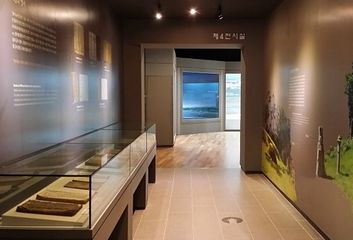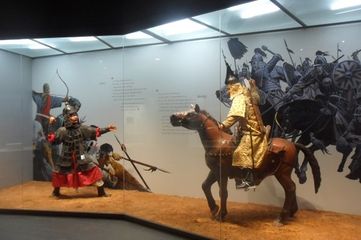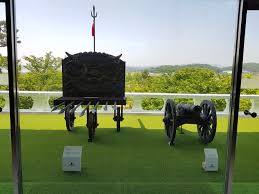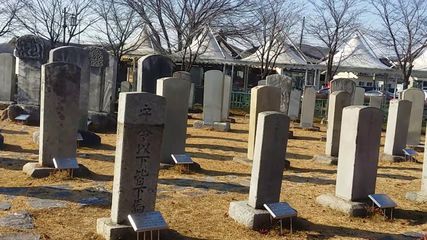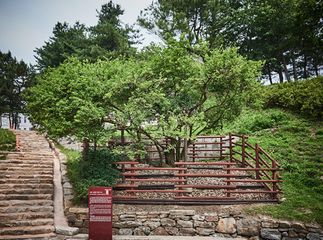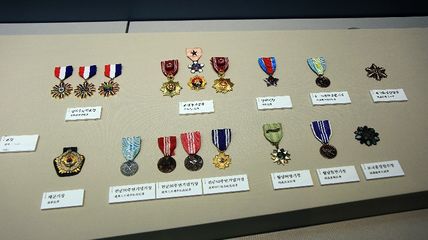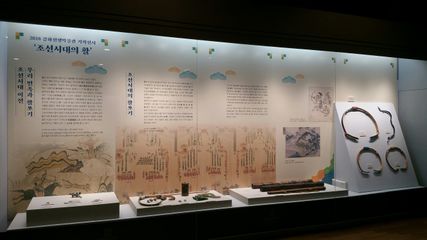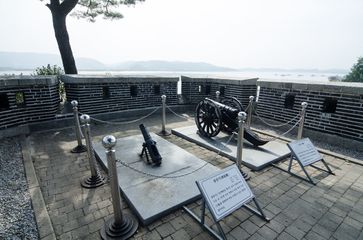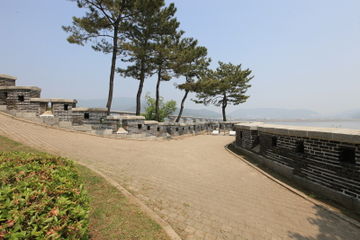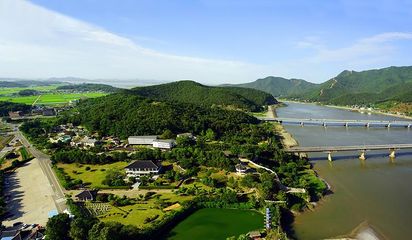"강화전쟁박물관"의 두 판 사이의 차이
Sharondesign (토론 | 기여) |
Sharondesign (토론 | 기여) |
||
| (3명의 사용자에 의한 32개의 중간 편집이 숨겨짐) | |||
| 15번째 줄: | 15번째 줄: | ||
|경도 = 126.516097 | |경도 = 126.516097 | ||
|사진 = 17042_25909_511.jpg | |사진 = 17042_25909_511.jpg | ||
| − | |웹사이트 }} | + | |웹사이트 = [https://www.ganghwa.go.kr/open_content/museum_war/ Link]}} |
=='''개관'''== | =='''개관'''== | ||
| + | ==='''한국어'''=== | ||
강화의 호국정신을 널리 알리고, 강화에서 일어났던 전쟁을 주제로 각종 유물을 전시, 연구, 보존, 수집하기 위해 2015년 4월 17일 개관하였다. [https://terms.naver.com/entry.nhn?docId=578803&cid=46660&categoryId=46660 사적] 제306호 [https://terms.naver.com/entry.nhn?docId=565168&cid=46656&categoryId=46656 강화 갑곶돈](甲串墩) 내에 있으며, 기존의 [https://terms.naver.com/entry.nhn?docId=3569156&cid=58926&categoryId=58935 강화역사관]을 리모델링하여 사용하고 있다. 건물은 지하 1층, 지상 2층, 건축 총면적 993㎡, 부지면적 3,475㎡의 규모로, 300점 이상의 전쟁유물을 소장하고 있다. <ref> 두산백과 https://terms.naver.com/entry.nhn?docId=5664244&cid=40942&categoryId=35446 </ref> | 강화의 호국정신을 널리 알리고, 강화에서 일어났던 전쟁을 주제로 각종 유물을 전시, 연구, 보존, 수집하기 위해 2015년 4월 17일 개관하였다. [https://terms.naver.com/entry.nhn?docId=578803&cid=46660&categoryId=46660 사적] 제306호 [https://terms.naver.com/entry.nhn?docId=565168&cid=46656&categoryId=46656 강화 갑곶돈](甲串墩) 내에 있으며, 기존의 [https://terms.naver.com/entry.nhn?docId=3569156&cid=58926&categoryId=58935 강화역사관]을 리모델링하여 사용하고 있다. 건물은 지하 1층, 지상 2층, 건축 총면적 993㎡, 부지면적 3,475㎡의 규모로, 300점 이상의 전쟁유물을 소장하고 있다. <ref> 두산백과 https://terms.naver.com/entry.nhn?docId=5664244&cid=40942&categoryId=35446 </ref> | ||
| − | ===''' | + | ==='''영어'''=== |
GanghwaWarMuseum was opened on April 17, 2015 to publicize the spirit of Ganghwa's national anthem and to display, research, preserve and collect various artifacts under the theme of the war that took place in Ganghwa. It is located within the historicSite No. 306 Ganghwa Cape Gotdon and remodeled and used the existing Ganghwa History Hall. The building has one basement, two floors above the ground, a total area of 993 square meters of construction, and a site area of 3,475 square meters, and houses more than 300 war artifacts. | GanghwaWarMuseum was opened on April 17, 2015 to publicize the spirit of Ganghwa's national anthem and to display, research, preserve and collect various artifacts under the theme of the war that took place in Ganghwa. It is located within the historicSite No. 306 Ganghwa Cape Gotdon and remodeled and used the existing Ganghwa History Hall. The building has one basement, two floors above the ground, a total area of 993 square meters of construction, and a site area of 3,475 square meters, and houses more than 300 war artifacts. | ||
| − | =='''박물관 | + | ==='''러시아어'''=== |
| + | Музей памяти войны в Ганхва был открыт 17 апреля 2015 года для пропаганды духа патриотизма острова Ганхва, а также для демонстрации, исследования, сохранения и сбора различных артефактов на тему войны, произошедшей в Ганхве. Музей расположен в исторической крепости Ганхва Капкотдон(национальное достояние 306). Здание состоит из 1 подземного этажа, 2 надземных этажей, общей площадью застройки 993㎡, земельного участка 3475㎡ и имеет более 300 предметов войны. | ||
| + | |||
| + | ==='''지도'''=== | ||
| + | <googlemap width="800" height="400" lat="37.734769" lon="126.516097" type="normal" zoom="16" icon="http://maps.google.com/mapfiles/marker.png"> | ||
| + | 37.734769, 126.516097 , [http://www.ganghwa.go.kr/open_content/museum_war/ 강화전쟁박물관] | ||
| + | </googlemap> | ||
| + | |||
| + | =='''해설'''== | ||
| + | |||
| + | ==='''박물관 내부시설 / Museum facilities'''=== | ||
강화전쟁박물관은 1층의 제1~2전시실, 2층의 제3~4전시실 총 4가지 주제의 전시실이 마련되어 있으며 선사시대부터 근현대까지 강화의 전쟁사 관련 유물을 시대순으로 볼 수 있도록 전시하였다. <br/> | 강화전쟁박물관은 1층의 제1~2전시실, 2층의 제3~4전시실 총 4가지 주제의 전시실이 마련되어 있으며 선사시대부터 근현대까지 강화의 전쟁사 관련 유물을 시대순으로 볼 수 있도록 전시하였다. <br/> | ||
| − | * 제1전시실 (주제관) - 복합영상을 통해 건국부터 오늘날까지 외세의 침략에 맞선 강화의 호국역사를 살펴볼 수 있는 주제관이며, 돌화살촉, 고리자루칼, 청동화살촉 등 선사시대부터 남북국시대까지 강화지역의 전쟁 역사를 엿볼 수 있는 각종 무기가 전시되어 있다. | + | * 제1전시실 (주제관) - 복합영상을 통해 건국부터 오늘날까지 외세의 침략에 맞선 강화의 호국역사를 살펴볼 수 있는 주제관이며, 돌화살촉, [https://terms.naver.com/entry.nhn?docId=1637692&cid=43065&categoryId=43065 고리자루칼], 청동화살촉 등 선사시대부터 남북국시대까지 강화지역의 전쟁 역사를 엿볼 수 있는 각종 무기가 전시되어 있다. |
| − | * 제2전시실 (고려시대) - 몽고의 침략에 대항한 [https://terms.naver.com/entry.nhn?docId=565741&cid=46621&categoryId=46621 강화천도]를 중심으로 고려시대 강화의 전쟁 역사를 소개하는 공간이며, 고려시대의 철제은입사투구(鐵冠), 철투구(鐵鬪帽), 철도자(鐵刀子) 등 전시하였고, [https://terms.naver.com/entry.nhn?docId=5144370&cid=46656&categoryId=46656 강화중성]의 건설 모습을 [ | + | * 제2전시실 (고려시대) - 몽고의 침략에 대항한 [https://terms.naver.com/entry.nhn?docId=565741&cid=46621&categoryId=46621 강화천도]를 중심으로 고려시대 강화의 전쟁 역사를 소개하는 공간이며, 고려시대의 철제은입사투구(鐵冠), 철투구(鐵鬪帽), 철도자(鐵刀子) 등 전시하였고, [https://terms.naver.com/entry.nhn?docId=5144370&cid=46656&categoryId=46656 강화중성]의 건설 모습을 [https://terms.naver.com/entry.nhn?docId=1218979&cid=40942&categoryId=33089 디오라마]로 재현하였다. |
| − | * 제3전시실 (조선) - [ | + | * 제3전시실 (조선) - [https://terms.naver.com/entry.nhn?docId=547090&cid=46622&categoryId=46622 정묘호란]·[[병자호란]]과 [https://terms.naver.com/entry.nhn?docId=576433&cid=46623&categoryId=46623 병인양요]·[https://terms.naver.com/entry.nhn?docId=560203&cid=46623&categoryId=46623 신미양요] 당시 나라의 마지막 보루이자 방파제 역할을 수행한 강화의 전쟁 역사를 소개하는 공간으로 미해병대가 대여 형식으로 반환한 [https://terms.naver.com/entry.nhn?docId=580895&cid=46623&categoryId=46623 어재연] 장군의 [https://ko.wikipedia.org/wiki/%EC%96%B4%EC%9E%AC%EC%97%B0_%EC%9E%A5%EA%B5%B0%EA%B8%B0 수자기] 및 [https://terms.naver.com/entry.nhn?docId=547090&cid=46622&categoryId=46622 정묘호란] 당시 강화도로 피난한 인조를 수행했던 [http://www.incheon.go.kr/board/290/1518026 황효원] 장군이 사용했던 패월도(佩月刀) 등과 각종 무기류가 전시되어 있다. |
| − | * 제4전시실 (근현대) - 조선 말부터 오늘날에 이르기까지 강화의 근현대 전쟁 역사를 소개한 공간으로 의병전쟁, 6·25전쟁을 포함, 조선시대 주력 화포인 [ | + | * 제4전시실 (근현대) - 조선 말부터 오늘날에 이르기까지 강화의 근현대 전쟁 역사를 소개한 공간으로 의병전쟁, 6·25전쟁을 포함, 조선시대 주력 화포인 [https://terms.naver.com/entry.nhn?docId=1631154&cid=42955&categoryId=42955 불랑기포](佛狼機砲), 항일 의병들이 사용한 화승총(火繩銃), 대한제국 장교들이 사용한 군도(軍刀) 등 근현대 시대의 각종 전쟁 관련 유물들이 전시되고 있으며 [https://terms.naver.com/entry.nhn?docId=564105&cid=46623&categoryId=46623 초지진]의 수비대가 운요호와 교전하는 모습이 [https://terms.naver.com/entry.nhn?docId=1218979&cid=40942&categoryId=33089 디오라마]로 연출되어 있다. 제4전시실 끝에는 조선 말에 개발된 최초의 방탄조끼인 [https://terms.naver.com/entry.nhn?docId=3327202&cid=46637&categoryId=46637 면갑]을 입어볼 수 있는 체험 공간이 마련되어 있다. |
* 전시관과 로비를 활용하여 강화의 역사와 관련된 유물 및 사진을 다루는 기획 전시를 진행하기도 한다. <ref> 강화전쟁박물관 http://www.ganghwa.go.kr/open_content/museum_war/ </ref> | * 전시관과 로비를 활용하여 강화의 역사와 관련된 유물 및 사진을 다루는 기획 전시를 진행하기도 한다. <ref> 강화전쟁박물관 http://www.ganghwa.go.kr/open_content/museum_war/ </ref> | ||
| − | |||
| − | |||
The Ganghwa War Museum has four exhibition rooms where are first and second exhibition rooms on the first floor and the third and fourth exhibition rooms on the second floor, and exhibits relics related to the history of the war in Ganghwa from prehistoric times to modern times. <br/> | The Ganghwa War Museum has four exhibition rooms where are first and second exhibition rooms on the first floor and the third and fourth exhibition rooms on the second floor, and exhibits relics related to the history of the war in Ganghwa from prehistoric times to modern times. <br/> | ||
| − | |||
| − | |||
| − | |||
| − | |||
| − | |||
| − | |||
<gallery mode=packed-hover heights=160px> | <gallery mode=packed-hover heights=160px> | ||
| 48번째 줄: | 51번째 줄: | ||
File:강화전쟁박물관내부3.jpg | 박물관 4전시실 입구 | File:강화전쟁박물관내부3.jpg | 박물관 4전시실 입구 | ||
File:강화전쟁박물관내부1.jpg | 박물관 내부 | File:강화전쟁박물관내부1.jpg | 박물관 내부 | ||
| − | + | File:강화전쟁박물관내부9.jpg | 박물관내 포 | |
| − | File:강화전쟁박물관내부9.jpg | | + | |
</gallery> | </gallery> | ||
| + | ==='''박물관 야외 / Museum Outdoor'''=== | ||
| − | + | * 박물관이 위치한 [https://terms.naver.com/entry.nhn?docId=565168&cid=46656&categoryId=46656 강화 갑곶돈]에는 박물관 외에도 조선시대에 선정을 베푼 강화[https://terms.naver.com/entry.nhn?docId=539392&cid=46622&categoryId=46622 유수] 등 각종 영세불망비와 선정비, 금표비, 삼충(강흥업, 구원일, 황선신)사적비등 총 67기의 [https://terms.naver.com/entry.nhn?docId=1247806&cid=40942&categoryId=35446 강화비석군]과 천연기념물 제78호 [https://terms.naver.com/entry.nhn?docId=1057435&cid=40942&categoryId=33548 강화 갑곶리 탱자나무], 1398(태조 7년)년에 현 자리에 세워졌다가 무너진 후 1976년에 현재 모습으로 복원된 [https://terms.naver.com/entry.nhn?docId=2030402&cid=42856&categoryId=42856 이섭정]이 있다. | |
| − | + | ||
| − | * 박물관이 위치한 강화 | + | |
* 박물관 야외에 활쏘기 체험시설이 마련되어 있어 다양한 활동이 가능하다. <ref> 강화전쟁박물관 http://www.ganghwa.go.kr/open_content/museum_war/ </ref> | * 박물관 야외에 활쏘기 체험시설이 마련되어 있어 다양한 활동이 가능하다. <ref> 강화전쟁박물관 http://www.ganghwa.go.kr/open_content/museum_war/ </ref> | ||
| − | + | On outdoor museum, Ganghwa Gapgotdon, where the museum is located, is home to 67 Ganghwa Stone County including a variety of small Buddhist monuments, such as Ganghwa Yusu, which were selected during the Joseon Dynasty and Natural Monument No. 78 Ganghwa Gapgotri Tangja Tree. There is a archery experience facility in the outdoor area of the museum, enabling various activities. | |
| − | + | ||
| − | + | ||
| − | + | ||
<gallery mode=packed-hover heights=160px> | <gallery mode=packed-hover heights=160px> | ||
| − | File: | + | File:강화전쟁박물관외부4.jpg | 박물관 이섭정 |
| − | File: | + | File:강화비석군1.jpg | 야외 비석군 |
| − | File: | + | File:강화 탱자나무1.jpg | 갑곶리 탱자나무 |
</gallery> | </gallery> | ||
| − | + | ==='''박물관 관람안내 / Museum guide'''=== | |
| − | =='''박물관 관람안내'''== | + | |
관람시간은 오전 9시부터 오후 6시까지이며, 연중무휴이다. <br/> 강화전쟁박물관 관람요금은 갑곶돈대 관람요금에 포함되어 있으며 별도로 징수하지 않는다. <ref> 강화전쟁박물관 http://www.ganghwa.go.kr/open_content/museum_war/ </ref> | 관람시간은 오전 9시부터 오후 6시까지이며, 연중무휴이다. <br/> 강화전쟁박물관 관람요금은 갑곶돈대 관람요금에 포함되어 있으며 별도로 징수하지 않는다. <ref> 강화전쟁박물관 http://www.ganghwa.go.kr/open_content/museum_war/ </ref> | ||
| − | |||
The viewing hours are from 9 a.m. to 6 p.m. and are open 365 all day. <br/> The fee for viewing the Ganghwa War Museum is included in the fee for the tour of Gaggotdon and is not collected separately. | The viewing hours are from 9 a.m. to 6 p.m. and are open 365 all day. <br/> The fee for viewing the Ganghwa War Museum is included in the fee for the tour of Gaggotdon and is not collected separately. | ||
| − | + | ==='''박물관 유물 및 전시 / Museum relics and exhibitions'''=== | |
| − | + | 소장 유물은 구석기 1건, 청동기는 8건 61여점, 고려시대는 19건 23여점, 조선은 49건 105여점, 근현대는 36건 59여점, 기타 7건 17여점 등이 있으며, 주요 전시품으로는 1871년 [https://terms.naver.com/entry.nhn?docId=560203&cid=46623&categoryId=46623 신미양요] 때 강화도 수비대장이었던 순무중군(巡撫中軍) [https://terms.naver.com/entry.nhn?docId=580895&cid=46623&categoryId=46623 어재연]이 사용했던 군기(軍旗)인 [https://ko.wikipedia.org/wiki/%EC%96%B4%EC%9E%AC%EC%97%B0_%EC%9E%A5%EA%B5%B0%EA%B8%B0 수자기](帥字旗)가 있다. 당시 미군이 노획하여 [https://www.usna.edu/Museum/index.php 미국 해군사관학교박물관]에 보관하던 것을 2007년 장기대여 형식으로 반환하여 보관 중이다. | |
| − | + | ||
| − | + | ||
| − | + | ||
| − | + | ||
| − | + | ||
| − | + | ||
| − | =='''박물관 유물 및 전시'''== | + | |
| − | 소장 유물은 구석기 1건, 청동기는 8건 61여점, 고려시대는 19건 23여점, 조선은 49건 105여점, 근현대는 36건 59여점, 기타 7건 17여점 등이 있으며, 주요 전시품으로는 1871년 신미양요 때 강화도 수비대장이었던 순무중군(巡撫中軍) | + | |
기획전시로 총 11건이 있었으며, 현재 <[http://www.ganghwa.go.kr/open_content/museum_war/bbs/bbsMsgDetail.do?msg_seq=47&bcd=exhibit 강화의병과 3.1운동]> 2019-02-27 ~ 2019-04-22가 전시 중이다. 그 밖에 <[http://www.ganghwa.go.kr/open_content/museum_war/bbs/bbsMsgDetail.do?msg_seq=14&bcd=exhibit 강화화승총 100여 년만의 귀환]> 2015-10-12 ~ 2015-12-31, <[http://www.ganghwa.go.kr/open_content/museum_war/bbs/bbsMsgDetail.do?msg_seq=20&bcd=exhibit&pgno=1 위기 속에 꽃핀 문화- 대몽항쟁기 강화, 그리고 진도]> 2016-04-26 ~ 2016-06-30, <[http://www.ganghwa.go.kr/open_content/museum_war/bbs/bbsMsgDetail.do?msg_seq=44&bcd=exhibit 프랑스 군인 쥐베르가 기록한 병인양요]> 2016-04-26 ~ 2016-09-30, <[http://www.ganghwa.go.kr/open_content/museum_war/bbs/bbsMsgDetail.do?msg_seq=40&bcd=exhibit&pgno=1 조선시대 활] (각궁 외 60여점)> 2018-04-03 ~ 2018-05-13, <[http://www.ganghwa.go.kr/open_content/museum_war/bbs/bbsMsgDetail.do?msg_seq=44&bcd=exhibit 조선시대 검](환도, 목도, 예도, 창포검 등 30여 점)> 2017-05-01 ~ 2017-06-18 등이 있었다. | 기획전시로 총 11건이 있었으며, 현재 <[http://www.ganghwa.go.kr/open_content/museum_war/bbs/bbsMsgDetail.do?msg_seq=47&bcd=exhibit 강화의병과 3.1운동]> 2019-02-27 ~ 2019-04-22가 전시 중이다. 그 밖에 <[http://www.ganghwa.go.kr/open_content/museum_war/bbs/bbsMsgDetail.do?msg_seq=14&bcd=exhibit 강화화승총 100여 년만의 귀환]> 2015-10-12 ~ 2015-12-31, <[http://www.ganghwa.go.kr/open_content/museum_war/bbs/bbsMsgDetail.do?msg_seq=20&bcd=exhibit&pgno=1 위기 속에 꽃핀 문화- 대몽항쟁기 강화, 그리고 진도]> 2016-04-26 ~ 2016-06-30, <[http://www.ganghwa.go.kr/open_content/museum_war/bbs/bbsMsgDetail.do?msg_seq=44&bcd=exhibit 프랑스 군인 쥐베르가 기록한 병인양요]> 2016-04-26 ~ 2016-09-30, <[http://www.ganghwa.go.kr/open_content/museum_war/bbs/bbsMsgDetail.do?msg_seq=40&bcd=exhibit&pgno=1 조선시대 활] (각궁 외 60여점)> 2018-04-03 ~ 2018-05-13, <[http://www.ganghwa.go.kr/open_content/museum_war/bbs/bbsMsgDetail.do?msg_seq=44&bcd=exhibit 조선시대 검](환도, 목도, 예도, 창포검 등 30여 점)> 2017-05-01 ~ 2017-06-18 등이 있었다. | ||
<ref> 강화전쟁박물관 http://www.ganghwa.go.kr/open_content/museum_war/ </ref> | <ref> 강화전쟁박물관 http://www.ganghwa.go.kr/open_content/museum_war/ </ref> | ||
| − | |||
The collection includes 1 Paleolithic relic, 61 bronze in 8 cases, 23 Goryeo Dynasty in 19 cases, 105 Joseon Dynasty in 49 cases, 59 modern times in 36 cases and 17 in seven other cases. Among the major exhibits is Sujagy, a military flag used by Eo Jae-yeon, a captain of the garrison on Ganghwa Island, during Shinmiyangyo in 1871. The U.S. military seized it and kept it at the U.S. Naval Academy Museum in 2007 in the form of a long-term loan. | The collection includes 1 Paleolithic relic, 61 bronze in 8 cases, 23 Goryeo Dynasty in 19 cases, 105 Joseon Dynasty in 49 cases, 59 modern times in 36 cases and 17 in seven other cases. Among the major exhibits is Sujagy, a military flag used by Eo Jae-yeon, a captain of the garrison on Ganghwa Island, during Shinmiyangyo in 1871. The U.S. military seized it and kept it at the U.S. Naval Academy Museum in 2007 in the form of a long-term loan. | ||
<gallery mode=packed-hover heights=160px> | <gallery mode=packed-hover heights=160px> | ||
| − | File: | + | File:강화전쟁박물관내부6.jpg | 유물 |
| − | File: | + | File:강화전쟁박물관내부2.jpg | 유물 |
| − | File: | + | File:강화전쟁박물관내부7.jpg | 기획전시(활) |
</gallery> | </gallery> | ||
| + | ==='''강화 갑곶돈 / Ganghwa Gapgotdon'''=== | ||
| + | 박물관이 위치한 강화 갑곶돈대는 강화도 해안에 설치된 53[https://ko.wikipedia.org/wiki/%EB%8F%88%EB%8C%80 돈대(墩臺)] 가운데 하나이다. 1637년(인조 15) [[병자호란]]이 끝난 뒤 조선 정부는 강화도 방어책의 하나로 12 [https://terms.naver.com/entry.nhn?docId=112436&cid=41826&categoryId=41826 진보(鎭堡)]를 설치하였고, 그 뒤 진보와 진보 사이에도 여러 곳의 돈대를 쌓았다. 돈대는 1679년(숙종 5)에 어영군(御營軍) 3,000인과 함경·황해·강원 등 3도 승군(僧軍) 8,000인을 동원하여 40일 만에 축조하였다. 갑곶돈은 통진(通津)에서 강화로 들어가는 [https://terms.naver.com/entry.nhn?docId=1192831&cid=40942&categoryId=35446 갑곶나루]에 설치하였는데, 돈대 주위가 113보(步)였고 성벽 위에 낮게 쌓은 성가퀴인 치첩(雉堞)은 40개였다고 한다. 1866년(고종 3) [https://terms.naver.com/entry.nhn?docId=576433&cid=46623&categoryId=46623 병인양요] 때 프랑스 함대에 속한 600명의 군사가 이곳으로 상륙하여 강화성을 점령하였지만, [https://terms.naver.com/entry.nhn?docId=2011308&cid=42856&categoryId=42856 정족산성](鼎足山城) 전투에서 [https://terms.naver.com/entry.nhn?docId=580697&cid=46623&categoryId=46623 양헌수(梁憲洙)]가 이끈 부대에 패하여 물러났다. 1875년(고종 12)에는 갑곶돈에 갑곶포대가 설치되었다. 이 때 갑곶돈은 망해(望海)·제승(制勝)·염주(念珠) 등 세 포대와 함께 제물진(濟物鎭)의 관할에 속하였다. 1876년에 일본의 전권대신 [https://terms.naver.com/entry.nhn?docId=1169599&cid=40942&categoryId=34310 구로다 기요타카]〔黑田淸隆〕가 6척의 함선을 이끌고 와 이곳으로 상륙한 뒤 [https://terms.naver.com/entry.nhn?docId=570051&cid=46623&categoryId=46623 운요호 사건]의 책임을 물어 강압적으로 강화도 [http://dh.aks.ac.kr/Edu/wiki/index.php/%EC%97%B0%EB%AC%B4%EB%8B%B9%EC%98%9B%ED%84%B0 연무당](鍊武堂)에서 조선의 접견대관 [https://terms.naver.com/entry.nhn?docId=560736&cid=46623&categoryId=46623 신헌](申櫶)과 [https://terms.naver.com/entry.nhn?docId=565722&cid=46623&categoryId=46623 강화도 조약](한일수호조규, 병자수호조약)을 맺었다. 그 뒤 갑곶돈은 허물어져 일부만 남았던 것을 1976년에 복원하여 오늘에 이른다. <ref> 한국민족문화대백과 https://terms.naver.com/entry.nhn?docId=565168&cid=46656&categoryId=46656 </ref> | ||
| − | |||
| − | |||
| − | |||
| − | |||
Ganghwado Island is one of the 53 dongae set up on the coast. After the war ended in 1637 (the 15th year of King Injo's reign), the Joseon government set up 12 progressives as a defense measure against Ganghwa Island, after which it built several dongae points between progressives and progressives. Gapgotdon was installed on the side of the road from the Tongjin to Ganghwa. In 1866 (the 3rd year of King Gojong's reign), 600 soldiers from the French fleet landed here and occupied Ganghwado Castle, but they were defeated by Yang Heon-su in the battle of Jungjoksanseong Fortress. Afterwards, the Gatgotdon was torn down, and only part of it was restored in 1976 to this day. | Ganghwado Island is one of the 53 dongae set up on the coast. After the war ended in 1637 (the 15th year of King Injo's reign), the Joseon government set up 12 progressives as a defense measure against Ganghwa Island, after which it built several dongae points between progressives and progressives. Gapgotdon was installed on the side of the road from the Tongjin to Ganghwa. In 1866 (the 3rd year of King Gojong's reign), 600 soldiers from the French fleet landed here and occupied Ganghwado Castle, but they were defeated by Yang Heon-su in the battle of Jungjoksanseong Fortress. Afterwards, the Gatgotdon was torn down, and only part of it was restored in 1976 to this day. | ||
<gallery mode=packed-hover heights=160px> | <gallery mode=packed-hover heights=160px> | ||
| − | File: | + | File:갑곶돈대1.jpg | 갑곶돈대 전경 |
| − | File: | + | File:갑곶돈대4.jpg | 갑곶돈대 |
| − | File: | + | File:갑곶돈대2.jpg | 갑곶돈대 전체 |
</gallery> | </gallery> | ||
| + | =='''시각자료'''== | ||
| − | + | ==='''사진'''=== | |
| − | + | ||
| − | + | ||
| − | ===''' | + | |
| − | + | ||
| − | + | ||
<gallery mode=packed-hover heights=160px> | <gallery mode=packed-hover heights=160px> | ||
| − | File: | + | File:강화전쟁박물관외부1.jpg | 박물관과 갑곶돈대 입구 |
| − | File: | + | File:강화전쟁박물관외부2.jpg | 박물관 건물 |
| − | File: | + | File:갑곶돈대3.jpg | 박물관 전경 |
</gallery> | </gallery> | ||
| − | + | ==='''영상'''=== | |
| − | + | ||
| − | + | ||
| − | ===''' | + | |
| − | + | ||
| − | + | ||
| − | + | ||
| − | + | ||
| − | + | ||
| − | + | ||
| − | + | ||
| − | + | ||
| − | + | ||
| − | + | ||
| − | + | ||
| − | + | ||
| − | + | ||
| − | + | ||
| − | + | ||
| − | + | ||
| − | + | ||
| − | + | ||
| − | + | ||
| − | + | ||
| − | + | ||
| − | + | ||
| − | + | ||
| − | + | ||
| − | + | ||
* A&A문화연구소 curatorsim의 박물관답사 - 새로 개관한 강화전쟁박물관, 게시일: 2015년 5월 8일. | * A&A문화연구소 curatorsim의 박물관답사 - 새로 개관한 강화전쟁박물관, 게시일: 2015년 5월 8일. | ||
<html> | <html> | ||
<iframe width="800" height="400" src="https://www.youtube.com/embed/h1CLh1sR1SM" frameborder="0" allow="accelerometer; autoplay; encrypted-media; gyroscope; picture-in-picture" allowfullscreen></iframe> </html> | <iframe width="800" height="400" src="https://www.youtube.com/embed/h1CLh1sR1SM" frameborder="0" allow="accelerometer; autoplay; encrypted-media; gyroscope; picture-in-picture" allowfullscreen></iframe> </html> | ||
| + | |||
| + | ==='''가상현실'''<ref>[http://encykorea.aks.ac.kr/Contents/SearchNavi?keyword=%EC%96%B4%EC%9E%AC%EC%97%B0&ridx=2&tot=6 한국민족문화대백과사전 '강화 광성보' 사진]</ref>=== | ||
| + | -추후 드론과 파노라마사진을 넣을 곳입니다. | ||
=='''출처'''== | =='''출처'''== | ||
2019년 6월 19일 (수) 02:19 기준 최신판
| 강화전쟁박물관 | |
|---|---|
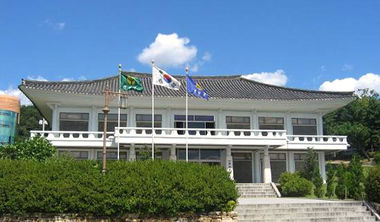
| |
| 지정 번호 | |
| 지정일 | |
| 지정 명칭 | |
| 한자 명칭 | 江華戰爭博物館 |
| 영문 명칭 | GanghwaWarMuseum |
| 분류 | 박물관 |
| 건립·제작 | 2015년 4월 17일 |
| 주소 | 강화군 강화읍 해안동로 1366번길 18 |
| 위도 | 37.734769 |
| 경도 | 126.516097 |
| 웹사이트 | Link |
목차
개관
한국어
강화의 호국정신을 널리 알리고, 강화에서 일어났던 전쟁을 주제로 각종 유물을 전시, 연구, 보존, 수집하기 위해 2015년 4월 17일 개관하였다. 사적 제306호 강화 갑곶돈(甲串墩) 내에 있으며, 기존의 강화역사관을 리모델링하여 사용하고 있다. 건물은 지하 1층, 지상 2층, 건축 총면적 993㎡, 부지면적 3,475㎡의 규모로, 300점 이상의 전쟁유물을 소장하고 있다. [1]
영어
GanghwaWarMuseum was opened on April 17, 2015 to publicize the spirit of Ganghwa's national anthem and to display, research, preserve and collect various artifacts under the theme of the war that took place in Ganghwa. It is located within the historicSite No. 306 Ganghwa Cape Gotdon and remodeled and used the existing Ganghwa History Hall. The building has one basement, two floors above the ground, a total area of 993 square meters of construction, and a site area of 3,475 square meters, and houses more than 300 war artifacts.
러시아어
Музей памяти войны в Ганхва был открыт 17 апреля 2015 года для пропаганды духа патриотизма острова Ганхва, а также для демонстрации, исследования, сохранения и сбора различных артефактов на тему войны, произошедшей в Ганхве. Музей расположен в исторической крепости Ганхва Капкотдон(национальное достояние 306). Здание состоит из 1 подземного этажа, 2 надземных этажей, общей площадью застройки 993㎡, земельного участка 3475㎡ и имеет более 300 предметов войны.
지도
해설
박물관 내부시설 / Museum facilities
강화전쟁박물관은 1층의 제1~2전시실, 2층의 제3~4전시실 총 4가지 주제의 전시실이 마련되어 있으며 선사시대부터 근현대까지 강화의 전쟁사 관련 유물을 시대순으로 볼 수 있도록 전시하였다.
- 제1전시실 (주제관) - 복합영상을 통해 건국부터 오늘날까지 외세의 침략에 맞선 강화의 호국역사를 살펴볼 수 있는 주제관이며, 돌화살촉, 고리자루칼, 청동화살촉 등 선사시대부터 남북국시대까지 강화지역의 전쟁 역사를 엿볼 수 있는 각종 무기가 전시되어 있다.
- 제2전시실 (고려시대) - 몽고의 침략에 대항한 강화천도를 중심으로 고려시대 강화의 전쟁 역사를 소개하는 공간이며, 고려시대의 철제은입사투구(鐵冠), 철투구(鐵鬪帽), 철도자(鐵刀子) 등 전시하였고, 강화중성의 건설 모습을 디오라마로 재현하였다.
- 제3전시실 (조선) - 정묘호란·병자호란과 병인양요·신미양요 당시 나라의 마지막 보루이자 방파제 역할을 수행한 강화의 전쟁 역사를 소개하는 공간으로 미해병대가 대여 형식으로 반환한 어재연 장군의 수자기 및 정묘호란 당시 강화도로 피난한 인조를 수행했던 황효원 장군이 사용했던 패월도(佩月刀) 등과 각종 무기류가 전시되어 있다.
- 제4전시실 (근현대) - 조선 말부터 오늘날에 이르기까지 강화의 근현대 전쟁 역사를 소개한 공간으로 의병전쟁, 6·25전쟁을 포함, 조선시대 주력 화포인 불랑기포(佛狼機砲), 항일 의병들이 사용한 화승총(火繩銃), 대한제국 장교들이 사용한 군도(軍刀) 등 근현대 시대의 각종 전쟁 관련 유물들이 전시되고 있으며 초지진의 수비대가 운요호와 교전하는 모습이 디오라마로 연출되어 있다. 제4전시실 끝에는 조선 말에 개발된 최초의 방탄조끼인 면갑을 입어볼 수 있는 체험 공간이 마련되어 있다.
- 전시관과 로비를 활용하여 강화의 역사와 관련된 유물 및 사진을 다루는 기획 전시를 진행하기도 한다. [2]
The Ganghwa War Museum has four exhibition rooms where are first and second exhibition rooms on the first floor and the third and fourth exhibition rooms on the second floor, and exhibits relics related to the history of the war in Ganghwa from prehistoric times to modern times.
박물관 4전시실 입구
박물관 내부
박물관내 포
박물관 야외 / Museum Outdoor
- 박물관이 위치한 강화 갑곶돈에는 박물관 외에도 조선시대에 선정을 베푼 강화유수 등 각종 영세불망비와 선정비, 금표비, 삼충(강흥업, 구원일, 황선신)사적비등 총 67기의 강화비석군과 천연기념물 제78호 강화 갑곶리 탱자나무, 1398(태조 7년)년에 현 자리에 세워졌다가 무너진 후 1976년에 현재 모습으로 복원된 이섭정이 있다.
- 박물관 야외에 활쏘기 체험시설이 마련되어 있어 다양한 활동이 가능하다. [3]
On outdoor museum, Ganghwa Gapgotdon, where the museum is located, is home to 67 Ganghwa Stone County including a variety of small Buddhist monuments, such as Ganghwa Yusu, which were selected during the Joseon Dynasty and Natural Monument No. 78 Ganghwa Gapgotri Tangja Tree. There is a archery experience facility in the outdoor area of the museum, enabling various activities.
박물관 이섭정
야외 비석군
갑곶리 탱자나무
박물관 관람안내 / Museum guide
관람시간은 오전 9시부터 오후 6시까지이며, 연중무휴이다.
강화전쟁박물관 관람요금은 갑곶돈대 관람요금에 포함되어 있으며 별도로 징수하지 않는다. [4]The viewing hours are from 9 a.m. to 6 p.m. and are open 365 all day.
The fee for viewing the Ganghwa War Museum is included in the fee for the tour of Gaggotdon and is not collected separately.박물관 유물 및 전시 / Museum relics and exhibitions
소장 유물은 구석기 1건, 청동기는 8건 61여점, 고려시대는 19건 23여점, 조선은 49건 105여점, 근현대는 36건 59여점, 기타 7건 17여점 등이 있으며, 주요 전시품으로는 1871년 신미양요 때 강화도 수비대장이었던 순무중군(巡撫中軍) 어재연이 사용했던 군기(軍旗)인 수자기(帥字旗)가 있다. 당시 미군이 노획하여 미국 해군사관학교박물관에 보관하던 것을 2007년 장기대여 형식으로 반환하여 보관 중이다.
기획전시로 총 11건이 있었으며, 현재 <강화의병과 3.1운동> 2019-02-27 ~ 2019-04-22가 전시 중이다. 그 밖에 <강화화승총 100여 년만의 귀환> 2015-10-12 ~ 2015-12-31, <위기 속에 꽃핀 문화- 대몽항쟁기 강화, 그리고 진도> 2016-04-26 ~ 2016-06-30, <프랑스 군인 쥐베르가 기록한 병인양요> 2016-04-26 ~ 2016-09-30, <조선시대 활 (각궁 외 60여점)> 2018-04-03 ~ 2018-05-13, <조선시대 검(환도, 목도, 예도, 창포검 등 30여 점)> 2017-05-01 ~ 2017-06-18 등이 있었다. [5]
The collection includes 1 Paleolithic relic, 61 bronze in 8 cases, 23 Goryeo Dynasty in 19 cases, 105 Joseon Dynasty in 49 cases, 59 modern times in 36 cases and 17 in seven other cases. Among the major exhibits is Sujagy, a military flag used by Eo Jae-yeon, a captain of the garrison on Ganghwa Island, during Shinmiyangyo in 1871. The U.S. military seized it and kept it at the U.S. Naval Academy Museum in 2007 in the form of a long-term loan.
유물
유물
기획전시(활)
강화 갑곶돈 / Ganghwa Gapgotdon
박물관이 위치한 강화 갑곶돈대는 강화도 해안에 설치된 53돈대(墩臺) 가운데 하나이다. 1637년(인조 15) 병자호란이 끝난 뒤 조선 정부는 강화도 방어책의 하나로 12 진보(鎭堡)를 설치하였고, 그 뒤 진보와 진보 사이에도 여러 곳의 돈대를 쌓았다. 돈대는 1679년(숙종 5)에 어영군(御營軍) 3,000인과 함경·황해·강원 등 3도 승군(僧軍) 8,000인을 동원하여 40일 만에 축조하였다. 갑곶돈은 통진(通津)에서 강화로 들어가는 갑곶나루에 설치하였는데, 돈대 주위가 113보(步)였고 성벽 위에 낮게 쌓은 성가퀴인 치첩(雉堞)은 40개였다고 한다. 1866년(고종 3) 병인양요 때 프랑스 함대에 속한 600명의 군사가 이곳으로 상륙하여 강화성을 점령하였지만, 정족산성(鼎足山城) 전투에서 양헌수(梁憲洙)가 이끈 부대에 패하여 물러났다. 1875년(고종 12)에는 갑곶돈에 갑곶포대가 설치되었다. 이 때 갑곶돈은 망해(望海)·제승(制勝)·염주(念珠) 등 세 포대와 함께 제물진(濟物鎭)의 관할에 속하였다. 1876년에 일본의 전권대신 구로다 기요타카〔黑田淸隆〕가 6척의 함선을 이끌고 와 이곳으로 상륙한 뒤 운요호 사건의 책임을 물어 강압적으로 강화도 연무당(鍊武堂)에서 조선의 접견대관 신헌(申櫶)과 강화도 조약(한일수호조규, 병자수호조약)을 맺었다. 그 뒤 갑곶돈은 허물어져 일부만 남았던 것을 1976년에 복원하여 오늘에 이른다. [6]
Ganghwado Island is one of the 53 dongae set up on the coast. After the war ended in 1637 (the 15th year of King Injo's reign), the Joseon government set up 12 progressives as a defense measure against Ganghwa Island, after which it built several dongae points between progressives and progressives. Gapgotdon was installed on the side of the road from the Tongjin to Ganghwa. In 1866 (the 3rd year of King Gojong's reign), 600 soldiers from the French fleet landed here and occupied Ganghwado Castle, but they were defeated by Yang Heon-su in the battle of Jungjoksanseong Fortress. Afterwards, the Gatgotdon was torn down, and only part of it was restored in 1976 to this day.
갑곶돈대 전경
갑곶돈대
갑곶돈대 전체
시각자료
사진
박물관과 갑곶돈대 입구
박물관 건물
박물관 전경
영상
- A&A문화연구소 curatorsim의 박물관답사 - 새로 개관한 강화전쟁박물관, 게시일: 2015년 5월 8일.
가상현실[7]
-추후 드론과 파노라마사진을 넣을 곳입니다.
출처
- ↑ 두산백과 https://terms.naver.com/entry.nhn?docId=5664244&cid=40942&categoryId=35446
- ↑ 강화전쟁박물관 http://www.ganghwa.go.kr/open_content/museum_war/
- ↑ 강화전쟁박물관 http://www.ganghwa.go.kr/open_content/museum_war/
- ↑ 강화전쟁박물관 http://www.ganghwa.go.kr/open_content/museum_war/
- ↑ 강화전쟁박물관 http://www.ganghwa.go.kr/open_content/museum_war/
- ↑ 한국민족문화대백과 https://terms.naver.com/entry.nhn?docId=565168&cid=46656&categoryId=46656
- ↑ 한국민족문화대백과사전 '강화 광성보' 사진
기여
일자 역할 이름 전공 2019년 4월 정리 및 편집 손형남 인문정보학
